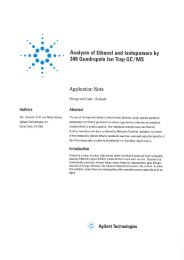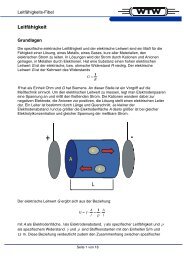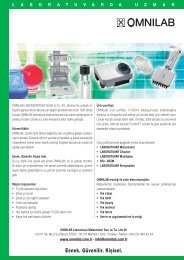Download PDF approx. 0,6 MB - Omnilab
Download PDF approx. 0,6 MB - Omnilab
Download PDF approx. 0,6 MB - Omnilab
You also want an ePaper? Increase the reach of your titles
YUMPU automatically turns print PDFs into web optimized ePapers that Google loves.
L A B O R A T O R Y C O M P E T E N C ECompact Knowledge:Correct Use and Handlingof Analytical- and MicrobalancesFlexible. Reliable. Personal.
Place of Installation of the BalanceWorkspaceResponse times too long? Weight values unstable? Drift?Unsatisfactory long-term stability?• Avoid or minimise structural vibration and vibration caused by machinery.• Place the balance table in a corner of the room, if possible, as thisis the most stable location.• Avoid direct sunlight; do not set up the balance on the south side ofthe room.• Optimum room features: shaded windows and only one door.• Set air conditioner to a minimal air current. If necessary, take stepsto protect the equipment from drafts caused by the air conditioner.• Ensure a constant room temperature (e.g., 21°C ± 2°C).• Observe the specified operating temperature range.• Keep in mind that proximity of air conditioners, open doors, andcomputer/laptop ventilation fans are sources of turbulence.• Do not set up the balance in close proximity to heat radiators,lamps or lighting fixtures.• Rapid changes in temperature influence results of measurement.Anti-Vibration Balance TableUnstable weight values? Poor repeatability?• Sartorius balances have excellent filtersfor eliminating interference; still,transfer of vibration through walls andfloors must be avoided.• A bracket for wall mounting, specialanti-vibration balance table or non -bending laboratory bench that does nothave contact with the wall can providea sufficiently stable work surface.• Do not use the surface on which the balance rests for writing or othertasks, as the balance will react to the slightest vibration or slant.HumidityPrecision weighing: not a ‘cut-and-dried’ procedure• The relative humidity at the place ofinstallation should be between 45% and60%. Changes in humidity can alter, forexample, the air buoyancy effect onweights and samples, thus influencingthe weight readout. If the humidity levelis too low, static electricity may result.• Use an ionising blower to neutralise static electricity as needed.• If the humidity level is particularly high, make absolutely sure toprevent condensation.
Operating the BalanceLevelling the BalanceOnly a level balance can deliver reliable results.• Adjust the feet until the level indicator shows that the balance is level;operate the balance only in this position. The air bubble must be within(ideally: in the middle) of the circle on the indicator.• After levelling the balance, perform calibration/adjustment (see below).Calibration, AdjustmentDetermine, evaluate and reduce deviationsPlacing a Sample on the BalanceReliable results: a ‘central’ topic• Center the sample as precisely as possible. If the load is not in themiddle of the weighing pan (off-center or eccentric loading), the weightreadout might be slightly skewed (off-center loading error).Weighing ProcedureA smooth, steady pace improves accuracy• Deviations in sensitivity/span should be determined at regular intervals(e.g., once a day) using a calibration weight. Calibration = determinationof the difference between nominal and actual values.• If tolerance limits are exceeded, the span accuracy must be adjusted.Adjustment = minimise or eliminate the difference determined in calibration.• Calibration is additionally required any time the ambient conditions (temperature,humidity or air pressure) change or the balance has been levelled.When the ‘isoCAL’ feature is active, the balance performs calibrationautomatically for greater accuracy. This also helps to reduce long-termeffects.IMPORTANT NOTE:It is essential that you observe the tolerance limits of the weights used forcalibration. For example, due to the permissible tolerance limits for a200-g class E2 calibration weight, the readout may differ from the actualweight by up to ±0.30 mg.• Always close the draft shield before reading the result.• Press the tare key to zero the display.• After positioning the sample/calibration weight on the pan, wait until‘g / mg’ (stability indicator) is displayed.• Note the weighing results at identical intervals (e.g., every 3 s); ifnecessary, set the stability parameter in the operating menu to meetyour requirements.• If more than 15 minutes have elapsed since the last individualweighing operation in a series, load the weighing pan briefly, unloadit again, and then tare the balance before continuing weighingoperations.Samples and ContainersDetermine the sample weight; reduce influencing factors• Use the smallest possible sample containerto reduce the effect of flow forces.• Plastic materials can cause static electricity (atvery low humidity, you may encounter the sameproblem with glass containers).• Never touch samples or sample containers withyour bare fingers (avoid leaving fingerprints).Wear gloves or use long anti-magnetic forceps.• Condition the sample container and sample tothe ambient temperature before weighing.• Avoid fluctuations in temperature; changes intemperature can cause an unstable readout. Ifthe objects weighed (sample/container) are toowarm, the value displayed will be too low; if toocold, then the value will be too high. (See alsothe installation and operating instructions.)Warmer = lighterColder = heavierCare of the BalanceCleanliness reduces disturbances• Keep the weighing pan and weighing chamber clean at all times.• Use a fine brush or hand-held vacuum cleaner to remove sampleresidues; if necessary, remove weighing pan and shield ring forcleaning.• Use an absorbent cloth to remove liquids.
Technical TermsAdjustmentAutotare/Auto zeroCalibrationConventional mass valueDriftGravitational acceleration (g)Influence quantityisoCALKilogramLevel indicatorLinearity; linearity error;non-linearitySetting a weighing instrument to eliminate discrepancies between the value on the readout and the actual value for the mass on theweighing instrument (balance).The readout is automatically set to zero by the balance, to eliminate minor deviations andcorrect any slow zero point drift.Determination of the correlation between the displayed value and the true mass of the sample on the balance. Calibration does not entailmaking any changes within the weighing instrument.The conventional weight of a body is equal to the mass of a mass standard that has a density of 8 g/cm -3 , which keeps this body inequilibrium at 20°C and an air density of 1.2 mg/cm -3 .If a body has a density of 8 g/cm -3 , its conventional weight and its mass are identical.Slow change, over time, of the readout with a constant load on the balance.The acceleration imparted to an object during free fall due to the gravitational force of the Earth. Gravitational acceleration is locationdependent;due to centrifugal force, it is slower at the equator than at the poles. It also decreases as the altitude above sea level increases.In Germany, the mean gravitational acceleration is g = 9.81 ms -2 .Quantity that is not the subject of a measurement, but that affects its result.Most balances today come equipped with this type of fully automatic calibration/adjustment function, activated at specific or at userdefinedintervals. In addition, when a defined temperature difference is exceeded, the calibration/adjustment procedure is triggered automatically.This makes it possible to ensure the accuracy of the balance without operator intervention.International base unit of mass; defined by the mass of the international kilogram prototype in Sevres (France).Tool for horizontal adjustment.Deviation from the theoretical linear slope of the characteristic curve of two interdependent variables.If the zero point and adjustment are correct, the linearity can be determined from the positive or negative difference of the displayed valuefrom the actual load.Maximum permissible error in service Limits on the measurement error of a verified balance; may not be exceeded during operation of the balance. The maximum permissibleerror in service is twice the maximum permissible error on verification.Maximum permissible error on verification Limits on the measurement error which may not be exceeded when a balance is verified.(Measurement) uncertaintyShort form for --> Uncertainty of measurementMinimum sample quantity acc. to USP Section 41 of the USP specifies the use of balances and weights. It states that the minimum(United States Pharmacopeia)sample weight measured on a balance may not be less than 1,000 times the uncertainty of measurement (or the uncertainty ofmeasurement must not be greater than 0.1% the minimum sample weight). Tare loads, such as sample containers, may not be includedin the calculation of the minimum sample quantity.Determination of the minimum sample quantity must be performed and documented at the place of installation. Under good installationconditions, the minimum sample quantity for a semi-microbalance is generally 15 to 25 mg.Motorised calibration weightBuilt-in, semi- or fully automatic mechanism for calibration/adjustment of the balance for high accuracy. Because of the high accuracy ofthis internal method, a built-in, motorised calibration weight is preferable to an external weight.Non-automatic weighing instrument A non-automatic weighing instrument requires operator intervention during the weighing procedure; e.g., to place a sample on the balance(NAWI)or to obtain the result.Off-center loading error;Change in the value displayed when a given load is placed in different positions on the weighing pan.eccentricity; eccentric loadingppm Abbreviation for parts per million = 10 -6 (e. g., 0.0001 g of 100.0000 g)ReadabilityThe smallest difference in mass that can be displayed by the balanceRepeatabilityThe ability of the balance to produce the same result repeatedly under specified test conditions when the same load is placed on thebalance in the same manner multiple times in series (generally, 6 times). The --> standard deviation serves as a quantitative expressionof repeatability.The measurement of the repeatability must include both the balance specifications and the ambient conditions (vibration, fluctuating aircurrent/temperature/humidity, etc.). Operator handling of the balance is also included in the standard deviation.Reproducibility--> RepeatabilityResolutionNo standardised definition; generally used to indicate the quotient of maximum capacity and readability.Example: a semi-microbalance with a 230 g weighing capacity and a readability of 0.01 mg has a resolution of 23,000,000 [23 million]digits.)Response time--> Stabilisation timeSensitivityChange in the displayed value divided by the change in load which caused it. With a correctly adjusted balance that has a digital display,the sensitivity must always be exactly 1.
SpanStabilisation timeStandard deviationThe correlation of the displayed weight value with the conventional mass value of the test weight on the balance is checked.The test weight should be traceable to a national standard, and is subject to monitoring.The time that elapses between completely placing the sample on the balance and obtaining the final result of the measurement.The stabilisation time can be influenced by selecting a different digital filter algorithm in the balance operating menu.A mathematic quantity for assessment of a balance with respect to its repeatability.The standard deviations ‘s’ is defined aswhere:n = number of individual resultsx = arithmetic mean of the individual results x iTaringTemperature coefficientTraceabilityUncertainty of measurementVerificationVerification scale interval (e)Weighing instrument verifiablefor legal metrologyExample of a normal distribution:Within ± 1 s ± 1.5 s ± 2 s ± 3 sSets the display to zero when a load is on the balance. This allows the display to be zeroed when an empty container is on theweighing pan, and the net weight to be read off after the container has been filled.Relative alteration of a value (e.g., zero point or sensitivity) when the temperature changes; the value is divided by the amountof temperature change.It can be stated in ppm/K or 10 -6 /K;e.g., a temperature change of 1 Kelvin (1°C) and a temperature coefficient of 1 · 10 -6 /K yields:Δm = 1 · 10-6 K-1 · 1 K · 100 g = 0.0001 gCharacteristic of a measurement result that can be traced back to a national or international reference weight through an unbrokenchain comparative weighing operations.This indicates the range above and below the result of measurement within which the unknown, error-free result lies with astatistical certainty of generally 95%.Example of a weighing result indicated with the uncertainty of measurement:m = (139.27457 ± 0.00002) g.Sartorius technicians can determine the uncertainty of measurement at the place of use of the balance and record it an officialcalibration certificate (accredited by the German Calibration Service, or DKD, in Germany for instance).Designation of the relative uncertainty of measurement (relative to the initial weight) is an important parameter for evaluation inthe laboratory environment.The legally mandated evaluation of a measuring instrument to determine its conformity with legal requirements, based on botha technical examination and the labeling of the instrument.A value expressed in a legal unit of measurement (mg, g, kg, t, ct) used during the evaluation of the weighing instrument andreferenced in defining the maximum permissible error on verification.A balance that has been approved for verification.Robert-Hooke-Str. 8 · D-28359 Bremen / Germany · Phone +49 (0)421 / 1 75 99-0www.omnilab.de · international@omnilab.deFlexible. Reliable. Personal.
















